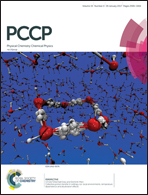In situ X-ray absorption near edge structure studies and charge transfer kinetics of Na6[V10O28] electrodes†
Abstract
Polyoxometalates (POMs) have been reported as promising electrode materials for energy storage applications due to their ability to undergo fast redox reactions with multiple transferred electrons per polyanion. Here we employ a polyoxovanadate salt, Na6[V10O28], as an electrode material in a lithium-ion containing electrolyte and investigate the electron transfer properties of Na6[V10O28] on long and short timescales. Looking at equilibrated systems, in situ V K-edge X-ray absorption near edge structure (XANES) studies show that all 10 V5+ ions in Na6[V10O28] can be reversibly reduced to V4+ in a potential range of 4–1.75 V vs. Li/Li+. Focusing on the dynamic response of the electrode to potential pulses, the kinetics of Na6[V10O28] electrodes and the dependence of the fundamental electron transfer rate k0 on temperature are investigated. From these measurements we calculate the reorganization energy and compare it with theoretical predictions. The experimentally determined reorganization energy of λ = 184 meV is in line with the theoretical estimate and confirms the hypothesis of small values of λ for POMs due to electrostatic shielding of the redox center from the solvent.
![Graphical abstract: In situ X-ray absorption near edge structure studies and charge transfer kinetics of Na6[V10O28] electrodes](/en/Image/Get?imageInfo.ImageType=GA&imageInfo.ImageIdentifier.ManuscriptID=C6CP05768C&imageInfo.ImageIdentifier.Year=2017)


 Please wait while we load your content...
Please wait while we load your content...